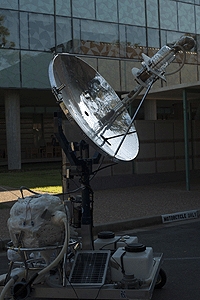The technology, developed at Rice’s Laboratory for Nanophotonics (LANP), has an overall energy efficiency of 24 per cent, whereas photovoltaic solar panels, by comparison, typically have an overall energy efficiency of around 15 per cent.
The inventors said in a statement that they expect the technology to be used initially for sanitation and water purification in developing countries.

‘This is about a lot more than electricity,’ said LANP director Naomi Halas, the lead scientist on the project, which is detailed in a paper published online in ACS Nano. ‘With this technology, we are beginning to think about solar thermal power in a completely different way.’
The efficiency of solar steam is a result of the light-capturing nanoparticles that convert sunlight into heat. When submerged in water and exposed to sunlight, the particles heat up so quickly that they instantly vaporise water and create steam. Halas said the solar steam’s overall energy efficiency can probably be increased as the technology is refined.
‘We’re going from heating water on the macroscale to heating it at the nanoscale,’ Halas said. ‘Our particles are very small — even smaller than a wavelength of light — which means they have an extremely small surface area to dissipate heat. This intense heating allows us to generate steam locally, right at the surface of the particle, and the idea of generating steam locally is really counterintuitive.’
Industrial steam
Steam is one of the world’s most used industrial fluids. About 90 per cent of electricity is produced from steam, and steam is also used to sterilise medical waste and surgical instruments, to prepare food and to purify water.
Most industrial steam is produced in large boilers, and Halas said solar steam’s efficiency could allow steam to become economical on a much smaller scale.
People in developing countries will be among the first to see the benefits of solar steam. Rice engineering undergraduates have already created a solar-steam-powered autoclave capable of sterilising medical and dental instruments at clinics that lack electricity.
‘Solar steam is remarkable because of its efficiency,’ said Rice graduate student Oara Neumann, lead co-author of the paper. ‘It does not require acres of mirrors or solar panels. In fact, the footprint can be very small. For example, the light window in our demonstration autoclave was just a few square centimetres.’





April 1886: the Brunkebergs tunnel
First ever example of a ground source heat pump?